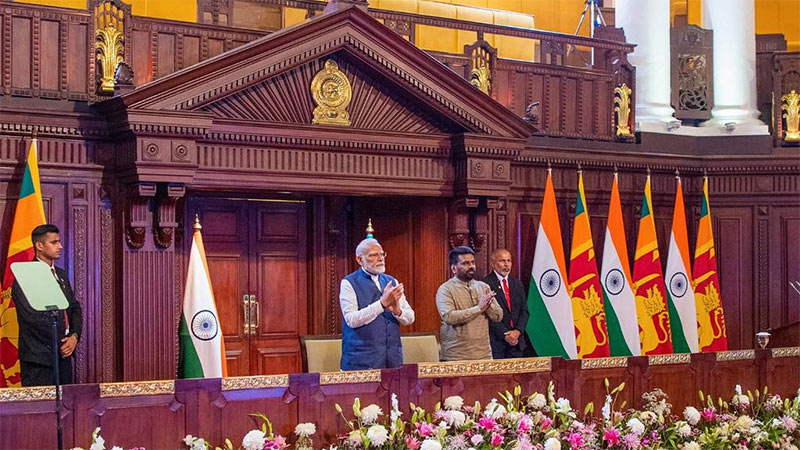Sri Lanka and India launch three key development projects to boost energy and agriculture

Sri Lanka and India jointly launched three major development projects yesterday (April 5), marking a significant step in strengthening bilateral cooperation.
The inauguration took place at the Presidential Secretariat in Colombo during the State visit of Indian Prime Minister Shri Narendra Modi, who was invited by Sri Lankan President Anura Kumara Dissanayake.
The three projects are:
- Construction of the Sampur Solar Power Plant
- Opening of the Agro Cold Storage Complex in Dambulla
- Installation of Solar Panels on 5,000 Religious Sites
President Dissanayake and Prime Minister Modi officially launched these projects using virtual technology after holding a formal meeting at the Presidential Secretariat.
Sampur Solar Power Plant
The Sampur Solar Power Plant is a key part of the Eastern Renewable Energy Zone under Sri Lanka’s Long Term Generation Expansion Plan. The project, developed by the Trincomalee Power Company, a joint venture between India’s NTPC Limited and Sri Lanka’s Ceylon Electricity Board, will be built in two phases.
The first phase will add 50 megawatts to the national grid using advanced N-type TOPCon solar cell technology. It will be constructed on 500 acres of land. The second phase is scheduled to begin in 2027. The project is expected to reduce carbon dioxide emissions by around 200,000 tonnes annually, supporting Sri Lanka’s move toward renewable energy.
Dambulla Agro Cold Storage Complex
The newly inaugurated Cold Storage Facility in Dambulla can store 5,000 metric tons of agricultural produce. Equipped with temperature and humidity controls, it aims to reduce post-harvest losses by about 40%, help stabilize food prices, and improve food quality and agricultural sustainability.
The complex includes six storage chambers, each capable of simulating different climatic conditions to support crop-specific research. This is the first facility of its kind in Sri Lanka and was built at a total cost of LKR 524 million, with LKR 300 million funded by the Indian Government as a grant and the remaining LKR 224 million by the Sri Lankan Government.
Solar Panels on 5,000 Religious Sites
India has also invested USD 17 million in a project to install solar panels on 5,000 religious sites across all 25 districts in Sri Lanka. This includes Buddhist, Hindu, Muslim, Catholic, and Christian places of worship.
Each site will receive a 5-kilowatt rooftop solar system, adding a total of 25 megawatts to the national grid. The project is jointly carried out by the Ceylon Electricity Board, Sri Lanka Sustainable Energy Authority, and Lanka Electricity Company (Pvt) Ltd. It reflects a shared commitment to creating a clean, reliable, and affordable energy system for the future.
Strengthening Ties
Prime Minister Modi’s visit reaffirms the strong friendship between the two nations, based on the theme “Friendship of Centuries, Commitment to a Prosperous Future.” The new projects highlight India’s ongoing support for Sri Lanka’s development and the growing partnership between the two countries.

Latest Headlines in Sri Lanka
- Sri Lanka cracks down on illegal liquor during new year season April 14, 2025
- Sri Lanka Prime Minister calls for unity and renewal this new year April 14, 2025
- Sri Lanka President urges nation to embrace unity and transformation April 14, 2025
- Lal Kantha: Ranil was the only one who could manage economy after collapse April 13, 2025
- Sri Lanka Coast Guard launches 24-hour emergency hotline 106 for maritime safety April 13, 2025


